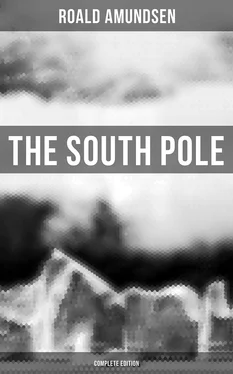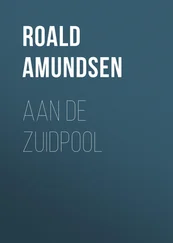One of the most important of our preparations was to find good dogs. As I have said, I had to act with decision and promptitude if I was to succeed in getting everything in order. The day after my decision was made, therefore, I was on my way to Copenhagen, where the Inspectors for Greenland, Messrs. Daugaard–Jensen and Bentzen, were to be found at that moment. The director of the Royal Greenland Trading Company, Mr. Rydberg, showed, as before, the most friendly interest in my undertaking, and gave the inspectors a free hand. I then negotiated with these gentlemen, and they undertook to provide 100 of the finest Greenland dogs and to deliver them in Norway in July, 1910. The dog question was thus as good as solved, since the choice was placed in the most expert hands. I was personally acquainted with Inspector Daugaard–Jensen from former dealings with him, and knew that whatever he undertook would be performed with the greatest conscientiousness. The administration of the Royal Greenland Trading Company gave permission for the dogs to be conveyed free of charge on board the Hans Egede and delivered at Christiansand.
Before I proceed to our further equipment, I must say a few more words about the dogs. The greatest difference between Scott’s and my equipment lay undoubtedly in our choice of draught animals. We had heard that Scott, relying on his own experience, and that of Shackleton, had come to the conclusion that Manchurian ponies were superior to dogs on the Barrier. Among those who were acquainted with the Eskimo dog, I do not suppose I was the only one who was startled on first hearing this. Afterwards, as I read the different narratives and was able to form an accurate opinion of the conditions of surface and going, my astonishment became even greater. Although I had never seen this part of the Antarctic regions, I was not long in forming an opinion diametrically opposed to that of Shackleton and Scott, for the conditions both of going and surface were precisely what one would desire for sledging with Eskimo dogs, to judge from the descriptions of these explorers. If Peary could make a record trip on the Arctic ice with dogs, one ought, surely, with equally good tackle, to be able to beat Peary’s record on the splendidly even surface of the Barrier. There must be some misunderstanding or other at the bottom of the Englishmen’s estimate of the Eskimo dog’s utility in the Polar regions. Can it be that the dog has not understood his master? Or is it the master who has not understood his dog? The right footing must be established from the outset; the dog must understand that he has to obey in everything, and the master must know how to make himself respected. If obedience is once established, I am convinced that the dog will be superior to all other draught animals over these long distances.
Another very important reason for using the dog is that this small creature can much more easily cross the numerous slight snow-bridges that are not to be avoided on the Barrier and on the glaciers. If a dog falls into a crevasse there is no great harm done; a tug at his harness and he is out again; but it is another matter with a pony. This comparatively large and heavy animal of course falls through far more easily, and if this happens, it is a long and stiff job to get the beast hauled up again — unless, indeed, the traces have broken and the pony lies at the bottom of a crevasse 1,000 feet deep.
And then there is the obvious advantage that dog can be fed on dog. One can reduce one’s pack little by little, slaughtering the feebler ones and feeding the chosen with them. In this way they get fresh meat. Our dogs lived on dog’s flesh and pemmican the whole way, and this enabled them to do splendid work.
And if we ourselves wanted a piece of fresh meat we could cut off a delicate little fillet; it tasted to us as good as the best beef. The dogs do not object at all; as long as they get their share they do not mind what part of their comrade’s carcass it comes from. All that was left after one of these canine meals was the teeth of the victim — and if it had been a really hard day, these also disappeared.
If we take a step farther, from the Barrier to the plateau, it would seem that every doubt of the dog’s superiority must disappear. Not only can one get the dogs up over the huge glaciers that lead to the plateau, but one can make full use of them the whole way. Ponies, on the other hand, have to be left at the foot of the glacier, while the men themselves have the doubtful pleasure of acting as ponies. As I understand Shackleton’s account, there can be no question of hauling the ponies over the steep and crevassed glaciers. It must be rather hard to have to abandon one’s motive power voluntarily when only a quarter of the distance has been covered. I for my part prefer to use it all the way.
From the very beginning I saw that the first part of our expedition, from Norway to the Barrier, would be the most dangerous section. If we could only reach the Barrier with our dogs safe and well, the future would be bright enough. Fortunately all my comrades took the same view of the matter, and with their cooperation we succeeded not only in bringing the dogs safely to our field of operations, but in landing them in far better condition than when we received them. Their number was also considerably increased on the way, which seems to be another proof of a flourishing state of things. To protect them against damp and heat we laid a loose deck of planed boards about 3 inches above the fixed deck, an arrangement by which all the rain and spray ran underneath the dogs. In this way we kept them out of the water, which must always be running from side to side on the deck of a deep-laden vessel on her way to the Antarctic Ocean. Going through the tropics this loose deck did double service. It always afforded a somewhat cool surface, as there was a fresh current of air between the two decks. The main deck, which was black with tar, would have been unbearably hot for the animals; the false deck was high, and kept fairly white during the whole voyage. We carried awnings in addition, chiefly on account of the dogs. These awnings could be stretched over the whole vessel and give the dogs constant protection from the burning sun.
I still cannot help smiling when I think of the compassionate voices that were raised here and there — and even made their way into print — about the “cruelty to animals” on board the Fram. Presumably these cries came from tender-hearted individuals who themselves kept watch-dogs tied up.
Besides our four-footed companions, we took with us a two-footed one, not so much on account of the serious work in the Polar regions as for pleasant entertainment on the way. This was our canary “Fridtjof.” It was one of the many presents made to the expedition, and not the least welcome of them. It began to sing as soon as it came on board, and has now kept it going on two circumnavigations through the most inhospitable waters of the earth. It probably holds the record as a Polar traveller among its kind.
Later on we had a considerable collection of various families: pigs, fowls, sheep, cats, and — rats. Yes, unfortunately, we knew what it was to have rats on board, the most repulsive of all creatures, and the worst vermin I know of. But we have declared war against them, and off they shall go before the Fram starts on her next voyage. We got them in Buenos Aires, and the best thing will be to bury them in their native land.
On account of the rather straitened circumstances the expedition had to contend with, I had to look twice at every shilling before I spent it. Articles of clothing are an important factor in a Polar expedition, and I consider it necessary that the expedition should provide each of its members with the actual “Polar clothing.” If one left this part of the equipment to each individual, I am afraid things would look badly before the journey was done. I must admit that there was some temptation to do this. It would have been very much cheaper if I had simply given each man a list of what clothes he was required to provide for himself. But by so doing I should have missed the opportunity of personally supervising the quality of the clothing to the extent I desired.
Читать дальше












